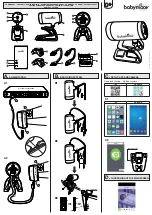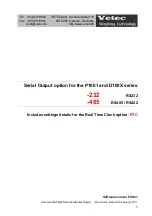
Measurement Applications
3–8
WFM 601i Serial Component Monitor
Table 3–1: Risetime conversions for WFM 601i.
20–80% Risetime measured
on WFM 601i in EYE mode
Actual 20–80% Risetime
640 ps
400 ps
710 ps
500 ps
780 ps
600 ps
860 ps
700 ps
900 ps
750 ps
940 ps
800 ps
1.0 ns
900 ps
1.1 ns
1.0 ns
1.2 ns
1.1 ns
1.3 ns
1.2 ns
1.4 ns
1.3 ns
1.5 ns
1.4 ns
1.6 ns
1.5 ns
Risetime has a more pronounced effect on system performance at 270 Mb/s than
at either 143 or 177 Mb/s. This is because of the shorter minimum time between
bit transitions. Although current specifications allow for 20 – 80% risetimes of
750 ps to 1.5 ns, risetimes of 1ns or less are recommended for 270 Mb/s
systems.
Timing jitter is the deviation of signal transitions compared to those of a
reference clock. Ideally, all transitions should occur at equal intervals. But
additive noise, pulse distortion, and variations in bit patterns all combine to
cause jitter. Jitter results in eye closure along the time axis, narrowing the
window in which the data values can be accurately determined. Data errors result
if the eye opening becomes too small.
Jitter is characterized by both its magnitude and frequency. That is, the signal
transitions deviate from their ideal position by some peak amount and at some
rate. The frequency of the jitter is important in determining its effect on the
system. Typically, only high frequency jitter affects data recovery. But low
frequency jitter can affect operations such as signal multiplexing and D/A
conversion.
The WFM 601i incorporates three different jitter high pass filters: 10 Hz, 100
Hz, and 1 kHz. With these filters the Eye pattern display will only show those
jitter terms above the selected high pass. For example, if 1 kHz is selected, a 50
Hz jitter term would be heavily attenuated and would not deviate the displayed
eye crossings while a 10 kHz term would appear unattenuated.
Measuring Jitter
Summary of Contents for WFM 601i
Page 4: ......
Page 12: ...Contents vi WFM 601i Serial Component Monitor...
Page 16: ...Preface x WFM 601i Serial Component Monitor...
Page 17: ...Getting Started...
Page 18: ......
Page 51: ...Operating Basics...
Page 52: ......
Page 58: ...At A Glance 2 6 WFM 601i Serial Component Monitor...
Page 76: ...Functional Overview 2 24 WFM 601i Serial Component Monitor...
Page 77: ...Reference...
Page 78: ......
Page 104: ...Measurement Theory 3 26 WFM 601i Serial Component Monitor...
Page 105: ...Appendices...
Page 106: ......
Page 118: ...Appendix B Multipin Connectors B 4 WFM601i Serial Component Monitor...
Page 123: ...Glossary...
Page 124: ......
Page 129: ...Index...
Page 130: ......
Page 134: ......
Page 135: ......
















































